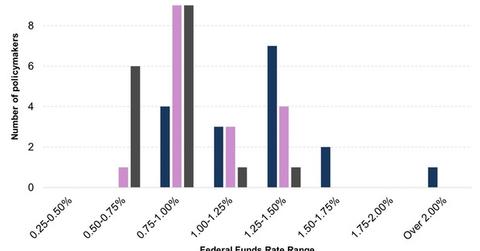Why the Divergence on the Rate Hike Timing in the US?
As a group, policymakers seem utterly confused regarding their reading of the economic situation, inflation, and the labor market.
Nov. 20 2020, Updated 1:16 p.m. ET

Opposing views
During 1Q15, when it was becoming clear that the expected rate hike in June may not materialize, policymakers were united in expressing this perspective in both policy statements and their respective speeches.
However, 2016 has been different for the most part. We’ve heard mixed opinions regarding a rate hike. This is also reflected in the changes in the dot plot, which is released once a quarter and shows policymakers’ views on their expected range of the federal funds rate at the end of the year. The graph below also shows these views.
In the April meeting, monetary policymakers sounded hawkish about a rate hike in the June meeting. However, in June, a dovish stance returned in the wake of the then impending Brexit vote. We’re back to at least a semi-aggressive tone at present.
But even with the slightly aggressive overall stance, there are a few who want to wait, some who can almost smell the next rate hike, and at least one who thinks a hike should already have occurred.
The reasons for this divergence
As a group, policymakers seem utterly confused regarding their reading of the economic situation, inflation, and the labor market. Though money managers like Janus and Richard Bernstein Advisors firmly believe that inflation is heading north, some policymakers don’t seem so sure.
They’re being cautiously optimistic about a rate hike, giving them elbow room to take action if deemed necessary at the September meeting. However, their guarded statements and meeting minutes are expected to save them from any criticism regarding a delayed or deferred rate hike. This divergence, however, can result in a further loss of face for policymakers.
As we saw in the previous article, equity market participants (ITOT) (FV) haven’t taken the veiled threats to raise rates soon seriously. Utilities (PPL) (AEP) (EXC), which function as bond proxies, and don’t fare well in a rising interest rate environment, actually rose after the release of the meeting minutes on August 17.
In the next articles, let’s look at the domestic factors that policymakers will consider while deciding on their monetary policy stance. Let’s begin with economic growth.
